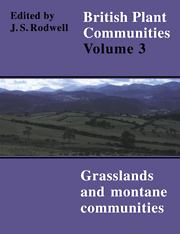Book contents
- Frontmatter
- Contents
- List of Figures
- Preface and Acknowledgements
- Preamble
- Mesotrophic Grasslands
- Community Descriptions
- Calcicolous Grasslands
- Community Descriptions
- Calcifugous Grasslands and Montane Communities
- Community Descriptions
- Index of Synonyms to Grasslands and Montane Communities
- Index of Species in Grasslands and Montane Communities
- Bibliography
U7 - Nardus Stricta-Carex Bigelowii Grass-Heath
Published online by Cambridge University Press: 04 July 2020
- Frontmatter
- Contents
- List of Figures
- Preface and Acknowledgements
- Preamble
- Mesotrophic Grasslands
- Community Descriptions
- Calcicolous Grasslands
- Community Descriptions
- Calcifugous Grasslands and Montane Communities
- Community Descriptions
- Index of Synonyms to Grasslands and Montane Communities
- Index of Species in Grasslands and Montane Communities
- Bibliography
Summary
Synonymy
Arctic-Alpine Grassland Smith 1911b p.p.; Rhacomitreto-Vaccinietum Smith 1911b p.p.; Nardus stricta-Carex bigelowii-Deschampsia flexuosa vegetation Watt & Jones 1948; Nardetum Metcalfe 1950, Burges 1951 p.p.; High altitude Nardus stricta sociation Poore 1955c; Nardus snow-beds Poore & McVean 1957; Low-alpine Nardus noda McVean & Ratcliffe 1962; Nardetum medio-alpinum McVean & Ratcliffe 1962; Nardus stricta-Vaccinium myrtillus Association Birks 1973; Nardus stricta-Carex bigelowii nodum Huntley 1979; Lycopodium alpinum-Nardus stricta community Birse 1980.
Constant species
Carex bigelowii, Galium saxatile, Nardus stricta, Vaccinium myrtillus, Racomitrium lanuginosum, Cladonia uncialis.
Rare species
Loiseleuria procumbens, Kiaeria starkei, Anas trophy llum donianum, Cetraria delisei.
Physiognomy
The Nardus stricta-Carex bigelowii grass-heath brings together some fairly diverse kinds of vegetation in which Nardus stricta is generally the dominant plant, with varying amounts of Carex bigelowii and Racomitrium lanuginosum, but where the local frequency and abundance of a range of associates can create some striking floristic and structural effects. The herbage is characteristically short, usually just a decimetre or so high, and the cover is generally closed or almost so, but in appearance the community varies from quite lush grassy swards, through heathy vegetation, to stands in which a ground layer of mosses or lichens plays a prominent part in the structure.
The overall abundance of Nardus often helps to pick out tracts of this community at a distance, the straw colour of its dead foliage contrasting sharply with the dull greys and greens that usually prevail over the surrounding slopes. Generally, it is the most extensive plant, sometimes overwhelmingly abundant, and with its dense tussocky growth it can exert a controlling influence on the distribution and vigour of many of the smaller associates. But C. bigelowii is equally characteristic of this vegetation: its high frequency is one of the best features distinguishing the community from subalpine Nardus-Galium grassland and it, too, can be quite abundant, growing especially robust in damper swards and frequently forming clonal patches that occur in mosaics with the Nardus clumps. Much less common throughout, but of local importance where the community extends on to wetter peaty soils, and then sometimes abundant over many hectares in this vegetation, is Scirpus cespitosus.
- Type
- Chapter
- Information
- British Plant Communities , pp. 379 - 388Publisher: Cambridge University PressPrint publication year: 1992

